USA Triathlon plays catch-up in the Triathlon Hall of Fame game

COLORADO SPRINGS, Colorado – OK OK. The World Triathlon Corporation and Triathlete Magazine beat USA Triathlon to the punch in the Hall of Fame game by a dozen or more years. By now, the more narrowly defined Ironman Hall of Fame has carefully meted out 15 or so honorees, while Triathlete has embraced the entire sport with 25 souls welcomed within its hallowed gates. Er, hollow gates might be a better description, since neither of triathlon’s first two halls of fame offer a brick and mortar nests filled with sacred memorabilia for the its immortals. No, triathlon’s halls for its immortals are far more virtual, far more in synch with the current belt-tightening recessionary climate than far fancier digs at football’s Canton, basketball’s Springfield and baseball’s Cooperstown. Triathlon Hall of Famers get an invite to a banquet in San Diego, an award or two, and bragging rights. Tri-fans wanting to look up either hallowed band of brothers and sisters do not have even a button to punch on the Ironman or the Triathlete websites. Instead, their portals are found through Google searches and oral tradition.
And now USA Triathlon, just after its 25th anniversary, has joined the fray filled with good intentions, carving out its own definition of triathlon history, in a spirited banquet at the historic Broadmoor Hotel near its Colorado Springs headquarters last Saturday night.
Making sure that a crowd of the more influential and history-minded persons would be there, USAT scheduled the ceremony at the finale of its influential race director’s conference. And so stalwarts like Eagleman and Columbia RD Rob Vigorito, Wildflower and Escape From Alcatraz’ Terry Davis, New York and Hy-Vee’s honcho Bill Burke, St. Anthony’s Phillip LaHaye, Buffalo Springs lake’s Mike and Marti Greer, and many more.
So when they all sat down to a dinner in the historic Broadmoor ballroom, so dimly lit and filled with classically garbed waiters it evoked dreams of Steven King’s ghostly tale of a winter Western resort, The Shining. But at the end of a sunny and unseasonably warm day where many ate lunch outdoors watching the geese on the pond, there was nothing ominous in the proceedings filled with bonhomie and happy memories.
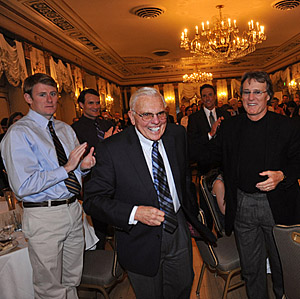
After a carefully considered nominating process, USA Triathlon came up with five names to start the ball rolling. Keeping in mind the officials who planted the roots of the national federation, they chose first 1984-89 Tri-Fed CEO Jon Gray Noll and early Tri-Fed Executive Director Verne Scott, aka Dave Scott’s father. The first class of athletes were all women — the late, inspirational age group champion Judy Flannery, two-time ITU World champion and 1995 Ironman Hawaii winner Karen Smyers and 2004 ITU World champion and the four-time Olympian in three separate sports, Sheila Taormina.
While many obvious choices were left waiting, and the profiles of the first edition may not match up to baseball’s 1939 opening class of that included Babe Ruth, Ty Cobb, and Christy Mathewson, the first USAT Hall of Fame edition had impeccable credentials and a decent rationales that marked out a particular USAT identity. With Dave Scott already residing in the Ironman and Triathlete Halls of Fame, USAT thought The Man might not mind leaving the opening night spotlight to his father. With John and Judy Collins honored both by Triathlete and the WTC for founding Ironman, the USAT selection committee likely decided to honor its own hardworking bureaucrat Noll. And with Paula Newby-Fraser already enshrined in two places, USAT decided to first honor Karen Smyers, who has not yet been honored by Triathlete or the Ironman but who pipped Newby-Fraser at Kona in 1995 and who also has two ITU World titles under her belt,. And while the WTC has honored the physically challenged competitors like Ricky Hoyt and Jon Blais and Triathlete honored the members of the San Diego Track Club who staged the very first triathlon on San Diego’s Fiesta Island, USAT decided to honor an age grouper for the ages, Judy Flannery. To those who may wonder why USAT didn’t honor outstanding male competitors like Mark Allen, Scott Molina, Scott Tinley, or Mike Pigg, the thinking might have been to carve out new territory with not previously honored Sheila Taormina, who has begun race directing in her retirement from elite competition after her precedent setting 4th Olympic appearance at Beijing in a third sport, modern pentathlon.
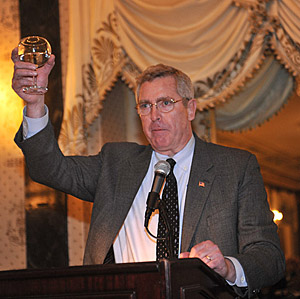
“The basketball hall of fame couldn’t start with Magic and Bird, they needed to kick things off with (basketball inventor) James Naismith,” said one USAT officer. To that end, they picked Noll, a lawyer who lent the original organization Triathlon Federation USA the money it needed to strike a deal for universal insurance coverage – a bedrock deal that lent stability to the sport. Noll, who now looks the part of a gray suited, silver tongued lawyer far more than his the lanky, dark haired incarnation seen on introductory slide show, retains his sense of humor and joy when recalling the early days. “It was an exciting time, and it was so much fun,” said Noll, who drew hearty laughs when he added “We didn't know what the heck we were doing but we kept moving…” When he ran past the allotted time, Noll, who had provided fine bottles of wine for every table, said “Hey, I bought drinks for the house, OK?”
Barry Siff told the audience that 84-year-old Verne Scott established rules, , event production standards, sanctioning processes, championships, membership drives, and the first members’ magazine from an office created in a vacant bedroom in his Davis, CA home. “Without Verne,” said Noll, “none of these would have been accomplished.’ Six-time Ironman champion and son Dave closed a humorous and warm introduction with these words; “This is a wonderful honor for a man who has been my father and a great model over the years… I could never keep up with him. He is a man with perseverance and tenacity beyond description.” Scott, who still coaches masters beginning swimming, hadn’t much to say about his own contributions, but saved his praise for folks like Al James, Ardis Bow, Dave Curnow and Noll. “There are so many others in this room equally deserving of the recognition that Jon and I and the athletes are getting tonight, so we are thankful for that.”
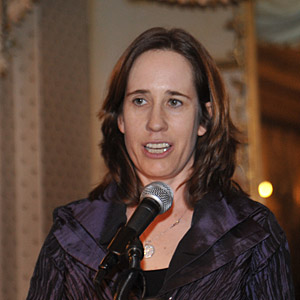
Judy Flannery, the late blooming triathlete who won four national triathlon titles, two duathlon national championships, four triathlon worlds golds and five duathlon world gold medals before being fatally injured by an errant driver while on a bike training ride in 1997, was represented by her daughter Erin Flannery. “If my mother were alive today, she would be 69 years old, and anticipating to advance to the 70-74 age group,” said Erin, who made a critically acclaimed documentary film about her charismatic and caring mother. “She would be beaming from ear to ear just as eager and as strong as ever,. And this morning, she would spring out of bed super early, eager to meet her friends for a for a bike ride or a run…and tonight she would have loved this event that brought us all together.”
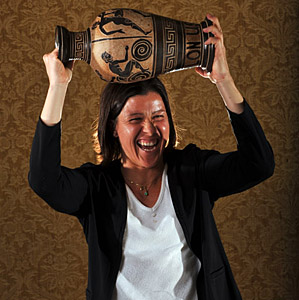
In a pre banquet interview, Karen Smyers noted with pleasure that the sport started out with egalitarian ideals. “At the very first ITU World Championship in France, as typical French people do, they decided the men were going to get more prize money,” said Smyers. “And the men, including Mike Pigg and Mark Allen, just stood up and said ‘We are not racing if you don’t make the purse equal with the women.’ Our sport was cutting edge and it has always been that way.”
In a similar interview, Taormina expressed deep gratitude that USA Triathlon picked her for their inaugural Hall of Fame class.. “After I finished the modern pentathlon at Beijing, I was walking around wondering if all the effort had been worth it,” said Taormina, who sold her house to fund her pursuit of her third Olympic sport in modern pentathlon. “So many people measure your success only by numbers and medals. And so when I finished 19th (after a disastrous fencing round that she countered with a perfect ride and a new record in the 200 meter swim) some people I knew didn’t even offer to shake my hand. When Tim Yount called and told me that USA Triathlon had selected me for the Hall of Fame, it meant so much to me because I felt they understood the big picture. I felt they understood what it took to get there and the spirit with which I approached the sport.”
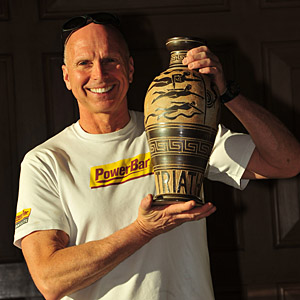
If nothing else, the USA Triathlon awards created by USA Triathlon official Judge Jones leaped to the head of the Hall of Fame class. Based on the original 776 BC Olympic vases and made with clay that comes as close as possible to original material, the amphoras were decorated with elegant athletic figures encircling the vases. All that clearly marked them as a modern day homage was the writing around the bottom of the vases: “USA TRIATHLON.”

